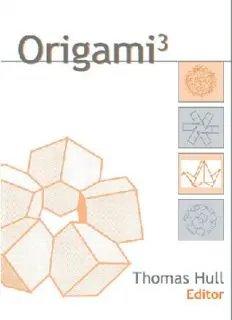
Origami 3: Third International Meeting of Origami Science, Mathematics, and Education Sponsored by Origami USA PDF
Preview Origami 3: Third International Meeting of Origami Science, Mathematics, and Education Sponsored by Origami USA
Origami3 Origami3 Third International Meeting of Origami Science, Mathematics, and Education Sponsored by OrigamiUSA Thomas Hull, Editor A K Peters Natick, Massachusetts Editorial, Sales, and Customer Service Office A K Peters, Ltd. 63 South Avenue Natick, MA 01760 www.akpeters.com Copyright © 2002 by A K Peters, Ltd. All rights reserved. No part of the material protected by this copyright notice may be reproduced or utilized in any form, electronic or mechanical, including photocopying, recording, or by any information storage and retrieval system, without written permission from the copyright owner. Library of Congress Cataloging-in-Publication Data International Meeting of Origami Science, Math, and Education (3rd : 2001 : Asilomar, Calif.) Origami3 : Third International Meeting of Origami Science, Math, and Education / Thomas Hull, editor. p. cm. Includes index. ISBN 1-56881-181-0 (pbk.) 1. Origami--Mathematics--Congresses. 2. Origami in education--Congresses. I. Title: Origami3. II. Title: Third: Third International Meeting of Origami Science, Math, and Education. III. Hull, Thomas. IV. Title. QA491 .I55 2001 736í.982--dc21 2002023871 Printed in Canada 06 05 04 03 02 10 9 8 7 6 5 4 3 2 1 Table of Contents Preface ix Part One: Mathematics of Origami 1 Recent Results in Computational Origami Erik D. Demaine and Martin L. Demaine.............................................. 3 A Disk-Packing Algorithm for an Origami Magic Trick Marshall Bern, Erik Demaine, David Eppstein, and Barry Hayes . . 17 The Combinatorics of Flat Folds: A Survey Thomas C. Hull....................................................................................... 29 A Mathematical Model for Non-Flat Origami sarah-marie belcastro and Thomas C. Hull........................................... 39 The Definition of Iso-Area Folding Jun Maekawa.......................................................................................... 53 The Geometry of Orizuru Toshikazu Kawasaki................................................................................ 61 V vi Table of Contents The Validity of the Orb, an Origami Model Jeannine Mosely .................................................................................. 75 Mathematical Origami: Another View of Alhazen's Optical Problem Roger C. Alperin..................................................................................... 83 Just Like Young Gauss Playing with a Square: Folding the Regular 17-gon Robert Geretschläger.............................................................................. 95 Paper-Folding Constructions in Euclidean Geometry: An Exercise in Thrift Benedetto Scimemi..................................................................................107 Part Two: Origami Science and Applications 119 Computer Tools and Algorithms for Origami Tessellation Design Alex Bateman..........................................................................................121 The Foldinator Modeler and Document Generator John Szinger .........................................................................................129 The Application of Origami Science to Map and Atlas Design Koryo Miura ........................................................................................137 Origami Pots Tomoko Fuse, Akira Nagashima, Yasuhiro Ohara and Hiroshi Okumura.............................................................................147 Polypolyhedra in Origami Robert J. Lang.........................................................................................153 Origami with Trigonometric Functions Miyuki Kawamura ...............................................................................169 Table of Contents vii A Study of Twist Boxes Noriko Nagata ......................................................................................179 To Fold or to Crumple? B. A. DiDonna ......................................................................................187 Folded Tubes as Compared to Kikko ("Tortoise-Shell") Bamboo Biruta Kresling.......................................................................................197 Square Cycles: An Introduction to the Analysis of Flexagons Ethan Berkove and Jeffrey Dumont........................................................209 Self-Assembling Global Shape Using Concepts from Origami Radhika Nagpal......................................................................................219 Part Three: Origami in Education 233 Applications of Origami to the Teaching of Sophisticated Communication Techniques Deborah Foreman-Takano......................................................................235 Origami and the Adult ESL Learner Lillian Yee Ho.........................................................................................247 Exploring the Possibilities of a Module Krystyna Burczyk and Wojciech Burczyk...............................................257 Using Graphs to Color Origami Polyhedra Charlene Morrow...................................................................................269 Circular Origami: A Survey of Recent Results Eva Knoll.................................................................................................283 In Praise of the Papercup: Mathematics and Origami at the University Emma Frigerio........................................................................................291 viii Table of Contents Using Triangular Boxes from Rectangular Paper to Enrich Trigonometry and Calculus V’Ann Cornelius and Arnold Tubis .....................................................299 Fold Paper and Enjoy Math: Origamics Kazuo Haga............................................................................................307 Origami as a Model for Development in Organisms Norman Budnitz......................................................................................329 Instances of Origami within Mathematics Content Texts for Preservice Elementary School Teachers Jack A. Carter and Beverly J. Ferrucci.................................................337 Contributors 345 Index 349 (cid:12)(cid:13)(cid:5)(cid:7)(cid:2)(cid:14)(cid:5) It is with much excitement and pleasure that I write the preface to Origami(cid:1), ProceedingsoftheThirdInternationalMeetingofOrigamiScience,Math,and Education(3OSME).Asprogramorganizerofthisconferenceandeditorofthis proceedings, this book symbolizes the completetion of three years of work. The first such conference, held in Ferrara, Italyin December of 1989, was titled The First International Meeting of Origami Science and Technology. Humiaki Huzita of the University of Padova was the father of this historic event. Therewereonly17talks,butthefoundationwaslaidforpeoplearound the globe to share their interests and research on the scientific, mathematical, and educational aspects of origami. The proceedings from the first meeting were ground-breaking, being the first publication to collect and disseminate paper-folding research. To this day, these proceedings are much sought-after. The Second International Meeting of Origami Science and Scientific Origami was held in Otsu, Japan in December of 1994; this was the first such meeting that I was able to attend. I was very impressed with the va- riety and scope of the talks, which covered everything from Miura’s uses of origami in designing solar panel arrays to Yoshizawa’s views on origami art; fromKawasaki’s work on abstract, high-dimensional flat-foldingtoKresling’s studiesoforigamipatternsinnature. Thejuxtapositionofideasinscience,art, education, and math made the Otsu meeting unique in the history of origami. This meeting also gave birth to a wonderful proceedings book; the organizers of the meeting and editors of the proceedings (Miura, Fuse, Kawasaki, and Maekawa) should be commended for their outstanding achievement. (cid:2)(cid:14)
